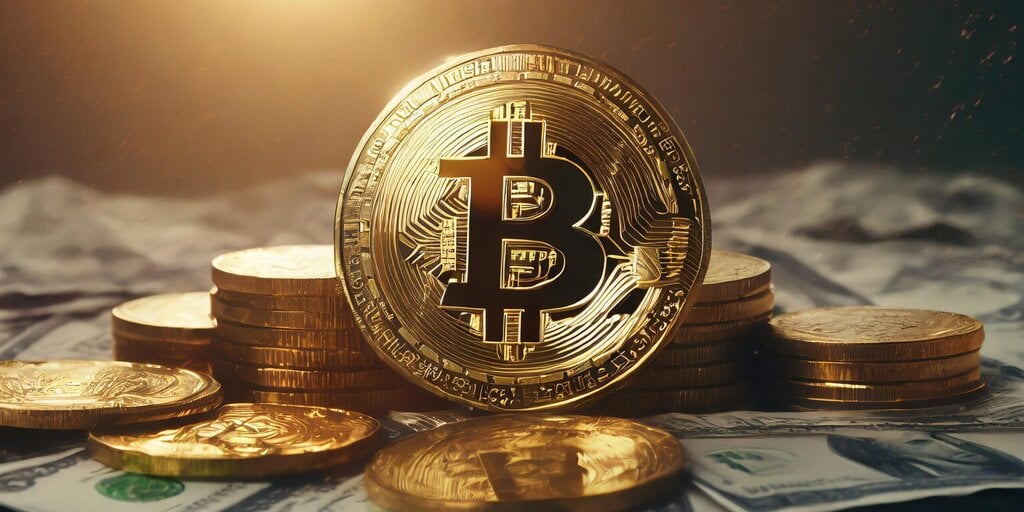Gold has never been more expensive. On Friday, the spot price of gold went above $2,500 for the first time in history. And now the cryptocurrency market finds itself at a critical juncture, with Bitcoin’s claim as “digital gold” facing its most significant challenge yet.
The precious metal’s rally has reignited debates about safe-haven assets in the digital age, forcing investors and analysts to reassess Bitcoin’s role in portfolio diversification and wealth preservation. This surge in traditional safe-haven demand comes amid a backdrop of global economic uncertainties and geopolitical tensions, putting Bitcoin’s resilience and market positioning under intense scrutiny.
While gold has surged to record highs over the last two weeks and is currently trading at $2,445 per ounce, Bitcoin currently trades at $65,450, down about 14% compared to its all time high of $73,737.94, according to CoinGecko.
As the two assets diverge in performance, questions arise about Bitcoin’s ability to serve as a reliable store of value and hedge against economic turbulence.
“It’s important to remember that the correlation between Bitcoin and gold has varied significantly since Bitcoin’s inception,” Vijay Pravin, Founder & CEO of bitsCrunch tells Decrypt. “In the early days, price movements of each asset were quite independent, but post-pandemic, the correlation between the two increased.”
This shifting dynamic highlights the complex relationship between gold and BTC, challenging long-held assumptions about cryptocurrency’s role in the financial ecosystem.
While gold continues to attract risk-averse investors seeking stability, Bitcoin’s path forward remains less certain, influenced by a unique set of factors including technological advancements, regulatory developments, and evolving market sentiment.
Rob Chang, CEO of Gryphon Digital Mining tells Decrypt that Bitcoin is fundamentally different from gold in terms of its digital nature, limited supply, and decentralized framework.
“Gold’s price movements may have an indirect impact on BTC as investors evaluate their portfolios, but Bitcoin’s unique attributes and the growing adoption of blockchain technology give it a distinct path,” according to Chang.
Amid geopolitical uncertainty, the divergence between gold and Bitcoin performance serves as a catalyst for reevaluating investment strategies in the digital age.
The current scenario not only tests Bitcoin’s mettle as a safe-haven asset but also opens up new discussions about the future of finance and the evolving nature of value storage in an increasingly digital world.
Highlighting the nuanced relationship between the two assets, Markus Levin, Co-founder at XYO tells Decrypt that when gold’s price rises, it can signal increased risk aversion, potentially boosting BTC as an alternative store of value.
“This suggests that while gold’s rally might not directly drive Bitcoin prices, it could create an environment more conducive to cryptocurrency investment,” Levin said.
The path forward for Bitcoin remains complex, with multiple factors influencing its potential to reach new heights.
Outlining the ideal conditions for Bitcoin’s growth, Romain Bailleul, COO of La Mine told Decrypt that for Bitcoin to achieve a new all-time high, several conditions are typically favorable: “A dovish Federal Reserve policy, increased adoption by institutional investors, positive regulatory developments, and technological advancements.”
These factors, combined with the approval of spot Bitcoin and Ethereum ETFs in the United States, have bolstered the cryptocurrency’s legitimacy.
However, the current geopolitical climate presents both opportunities and challenges for Bitcoin’s growth.
“Against a backdrop of environmental, geopolitical and macroeconomic uncertainty, the price of gold is likely to stabilize at elevated levels as investors increasingly lean towards safe-haven assets,” Pravin notes. “This trend could potentially spill over into the cryptocurrency market, particularly as investors seek diverse hedging options.”
The upcoming U.S. presidential election adds another layer of complexity to the situation.
“The current political climate in the US supports a bullish price target for Bitcoin, with both major candidates adopting more favorable stances towards digital assets,” Levin says.
This shifting political landscape could provide additional tailwinds for Bitcoin, potentially narrowing the performance gap with gold.
However, as Bitcoin continues to mature, its relationship with traditional financial indicators, including gold prices, is likely to evolve.
As the financial world grapples with these shifts, the gold-Bitcoin relationship will remain a key area of focus.
Whether or not Bitcoin can truly live up to its “digital gold” moniker in the face of economic uncertainty, its performance in the coming months could shape the future of safe-haven investments in the digital age.
Edited by Stacy Elliott.
Daily Debrief Newsletter
Start every day with the top news stories right now, plus original features, a podcast, videos and more.


